I enrolled in night school at UCLA because I wanted to develop my skills with something other than an online course. I’m a little burnt out on online courses and the funnels that sell them. I’ve been buying courses for eight years and not finishing them for nine. And I felt ready to learn from more seasoned experts — professors and editors who had decades of experience under their belts.
The UCLA night school building sits on the edge of campus in Westwood, about half a mile from the intersection of Sepulveda and Santa Monica boulevards. When I showed up to class, I sat alongside a dozen other adults ranging in age from 19 to 65 as our teacher handed out the first writing exercise.
“This is the most important skill you will learn in journalism school,” he said.
The assignment was to write a lead. Sometimes misspelled “lede” for journalism shorthand, a lead is a single sentence, paragraph, or section that summarizes the who, what, where, when, why, and how of your story.
Think of leads as being like movie trailers. You get a sense of what the movie is about, yet the teaser leaves you wanting more. There are also many variations on the lead — there is something for everyone.
Headlines are vital for successful content marketing, but to keep readers or viewers intrigued, you need a great lead, too. Here’s how this classic journalism technique can help you reach your goals.
Table of Contents
What Is a Lead (Lede)?
Before delving into the intricacies of a lead, it’s crucial to understand its purpose.
The lead is the opening paragraph or sentence of an article, designed to capture readers’ attention and entice them to continue reading. A well-crafted lead sets the tone for the rest of your writing and serves as a guide for the reader, highlighting the main points and generating curiosity.
In news, a lede serves readers by communicating what they need to know about current events. Marketers can benefit from this skill, too.
A lede will help you do the following:
- Reduce bounce rate. Readers will be less likely to dip out after just a few seconds, and may explore other pages on your website.
- Increase time on page. The longer readers stay on a page, the better it is for SEO. Time on page is a common quality metric in corporate media.
- Feed your sales funnel. Ledes aren’t just for articles; their logic applies to video scripts and sales pages, too. If readers hang around, you’re doing something right.
(For clarity, this definition of lead is different than a marketing lead — someone who has entered your sales funnel — and is distinct from the word lead as other parts of speech, such as “lead me to the nearest food truck, please.” 🌮)
Although there’s no one correct way to write a lead, some approaches are better than others based on the type of article. Journalists learn a core set of leads in year one to attract and engage readers. Here are nine different lead styles to know about.
Types of Leads for Writing Online
- Summary lead / straight news lead.
- Single-item lead.
- Anecdotal lead / analogous lead.
- Delayed identification lead.
- Scene-setting lead.
- Short sentence lead / zinger lead.
- First-person lead.
- Observational lead.
- Question lead.
@nickwolny1 Amazon/iRobot Deal Called Off Due to Regulation - Jan. 29, 2023: Amazon will pay a $94 million termination fee to abandon its purchase of Roomba maker iRobot. Was this the right move? Here’s what to know. In 2022, Amazon announced they were acquiring iRobot, maker of the Roomba vacuum and other products, for $1.7 billion. But since then, the deal has been mired by antitrust regulators in the EU, who are blocking the deal on grounds that it gives Amazon too much marketplace control, as they could delist or degrade access to competitors. Antitrust regulators ensure mergers and acquisitions don’t result in monopolies. Market competition keeps product prices down, which is better for consumers. In response, iRobot announced today they would lay off 31% of staff, about 350 employees. iRobot made $891 million in revenue in 2023, but ended at around a $275 million loss. In a joint statement, Amazon and iRobot said there was “no path to regulatory approval for the deal.” Should Amazon have been able to acquire iRobot? #news #journalist #journalism #amazon #smarthome #newsanchor #technews #regulation #europeanunion #vacuum #acquisition #layoffs ♬ original sound - Nick Wolny | News Journalist
In this TikTok, I use a lead sentence to get the point across quickly.
No. 1: Summary Lead / Straight News Lead
Of all the types of leads summary lead is the most common. It’s very popular when writing about hard news or breaking news, and if you’re new to writing, you can’t go wrong with a summary lead. This approach is also called a news lead or a direct lead.
Hannah Block, international news editor for National Public Radio (NPR), describes it well: “Just the facts, please, and even better if interesting details and context are packed in.”
The summary lead formula is simple: aspire to communicate most of the who, what, where, when, why, and how of your story (referred to hereafter as “the W’s”) in a single sentence.
This approach is preferred in news writing, which aspires to remain neutral and unbiased in its delivery of information, and creates immediate clarity. Prioritize active voice, journalistic writing, and proper AP style in a summary lead.
Here is an example from the Associated Press (AP).
“Intensifying its fight against high inflation, the Federal Reserve raised its key interest rate by a substantial three-quarters of a point for a third straight time and signaled more large rate hikes to come — an aggressive pace that will heighten the risk of an eventual recession.”(1)

AP’s business section has a “business highlights” subsection in which each article is a collection of leads and summary paragraphs. Read through it to get a feel for how to create clarity and context in a single paragraph that includes the most important information. AP News is free to read.
Here’s another example from Reuters:
“The Philadelphia Phillies ended their long wait for a World Series title with a short burst of baseball last night as they clinched the crown by completing a rain-suspended 4-3 win over the Tampa Bay Rays.” (2)

No. 2: Single-Item Lead
The single-item lead is similar to the summary lead, but this approach focuses just one or two of the W’s, rather than trying to stuff most or all of them into a single sentence.
This approach is good if your news story or article is very much driven by one particular detail or feeling, and since it’s shorter, it usually results in a bigger punch. Aim to land your idea in as few words as possible, preferably all in one sentence.
Let's rewrite the previous Reuters lead to demonstrate how it could be expressed as a single-item lead instead.
“The Philadelphia Phillies are World Champions again.”
No. 3: Anecdotal Lead / Analogy Lead
If the information you’re introducing to your audience is complex or overly conceptual, a more effective approach might be to use an analogy or anecdote instead.
The anecdotal lead is unique in that it does not communicate the W’s of the story, but rather leans on details or analogies to help the reader infer what the story is going to be about. The result is a more emotionally charged or stylistic lead that goes beyond hard facts and can pull readers in.
Pro Tip:An anecdote is any short story that illustrates a point.
These leads can use an overt analogy or be more descriptive. Here are examples of each.
The Cincinnati Post
“From Dan Ralescu’s sun-warmed beach chair in Thailand, the Indian Ocean began to look, oddly, not so much like waves but bread dough.”
ProPublica/The New York Times
“"I tucked Joel in, but I feel so guilty I didn’t hold him longer,” Julie Rea said, her voice welling with emotion. That is all she can muster about the worst night of her life. As she tries to say more, she breaks down."(3)
Resist the urge to use an anecdotal lead that is too cheesy or cliché. The objective of this lead is to use an anecdote to create depth and intrigue.

No. 4: Delayed Identification Lead
This lead focuses on an action or situation without revealing who is involved at first. It is good to use when someone wants to emphasize a scenario or situation effectively before revealing the W’s. When done well, it pulls people in.
In the first debate for the United States Democratic Primary in 2020, Kamala Harris used a delayed-identification lead in one of her talking points on busing legislation to great effect.
“There was a little girl in California who was part of the second class to integrate their public schools, and she was bused to school every day. That little girl was me.”
No. 5: Scene-Setting Lead
The scene-setting lead creates depth and detail. It is more lush and narrative, and is great for creating vividness or setting the stage for longer pieces.
Usually, the primary intention of the lead is to establish clarity quickly, but in literary journalism and other more longform approaches, taking the time to set the stage at the beginning often results in a more effective piece.
Here is an example of a scene-setting lead from BuzzFeed.
“For seven years before the murder, Dee Dee and Gypsy Rose Blancharde lived in a small pink bungalow on West Volunteer Way in Springfield, Missouri. Their neighbors liked them. “'Sweet' is the word I’d use,” a former friend of Dee Dee’s told me not too long ago. Once you met them, people said, they were impossible to forget.” (4)
Here is another example, a sentence from the book Beloved by Toni Morrison.
“Winter in Ohio was especially rough if you had an appetite for color. Sky provided the only drama, and counting on a Cincinnati horizon for life’s principal joy was reckless indeed.”
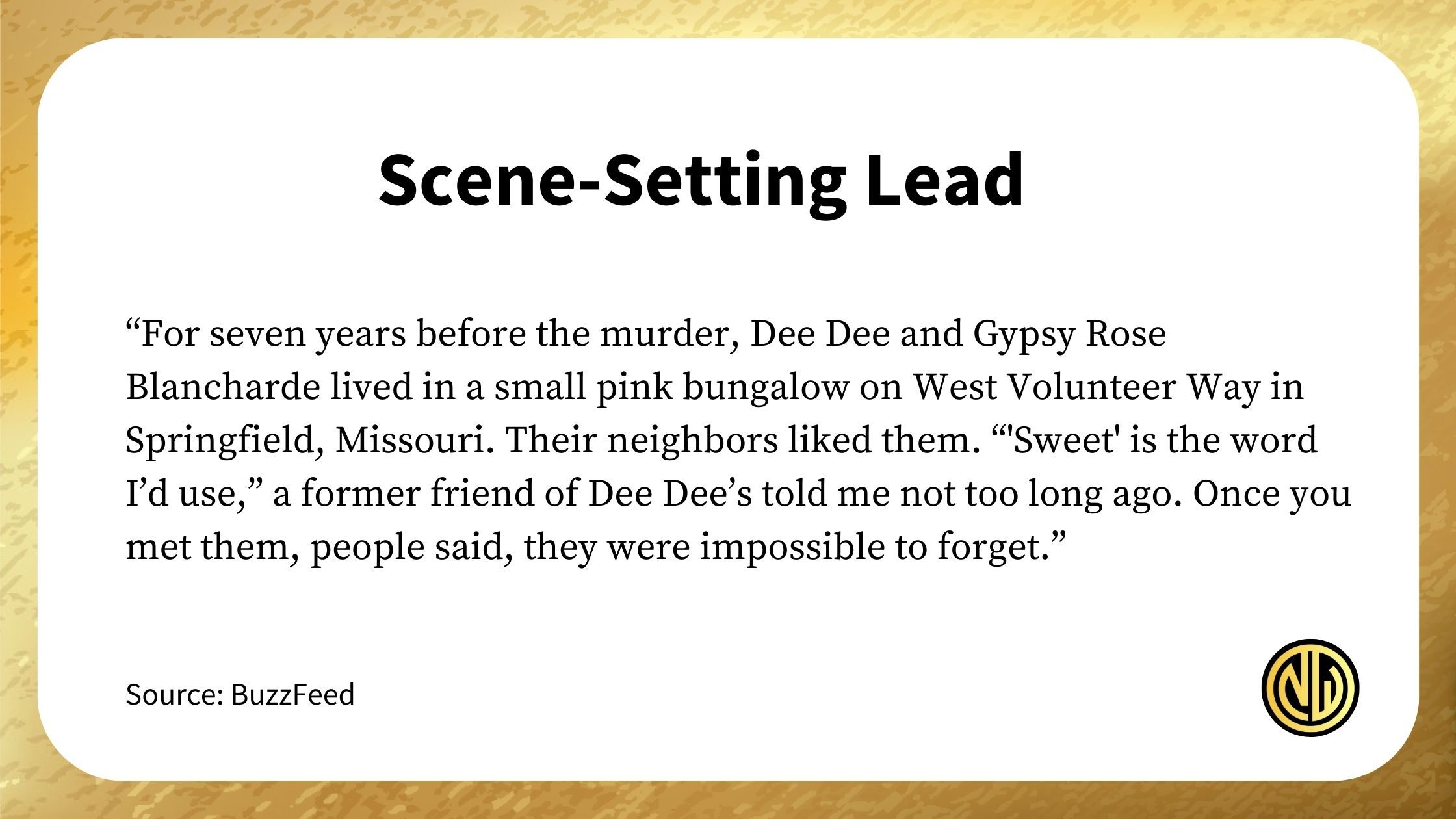
No. 6: Short Sentence Lead / Zinger Lead
This type of lead is when you pack a punch with the first sentence of your article to capture a reader’s attention. It can be sassy, shocking, unexpected, compelling, or all of the above.
Usually, when using a zinger lead, the following paragraphs fill in missing details and function like a regular lead.
Here is a sassy example from the Philadelphia Enquirer.
“Philadelphians don’t need anyone’s approval, especially not New Yorkers. But that doesn’t mean we don’t care when we get recognition.” (5)
Here is another example from the Miami Herald. This was a story about a man who attempted to smuggle cocaine by swallowing balloons of it.
“His last meal was worth $30,000 and it killed him.” (6)
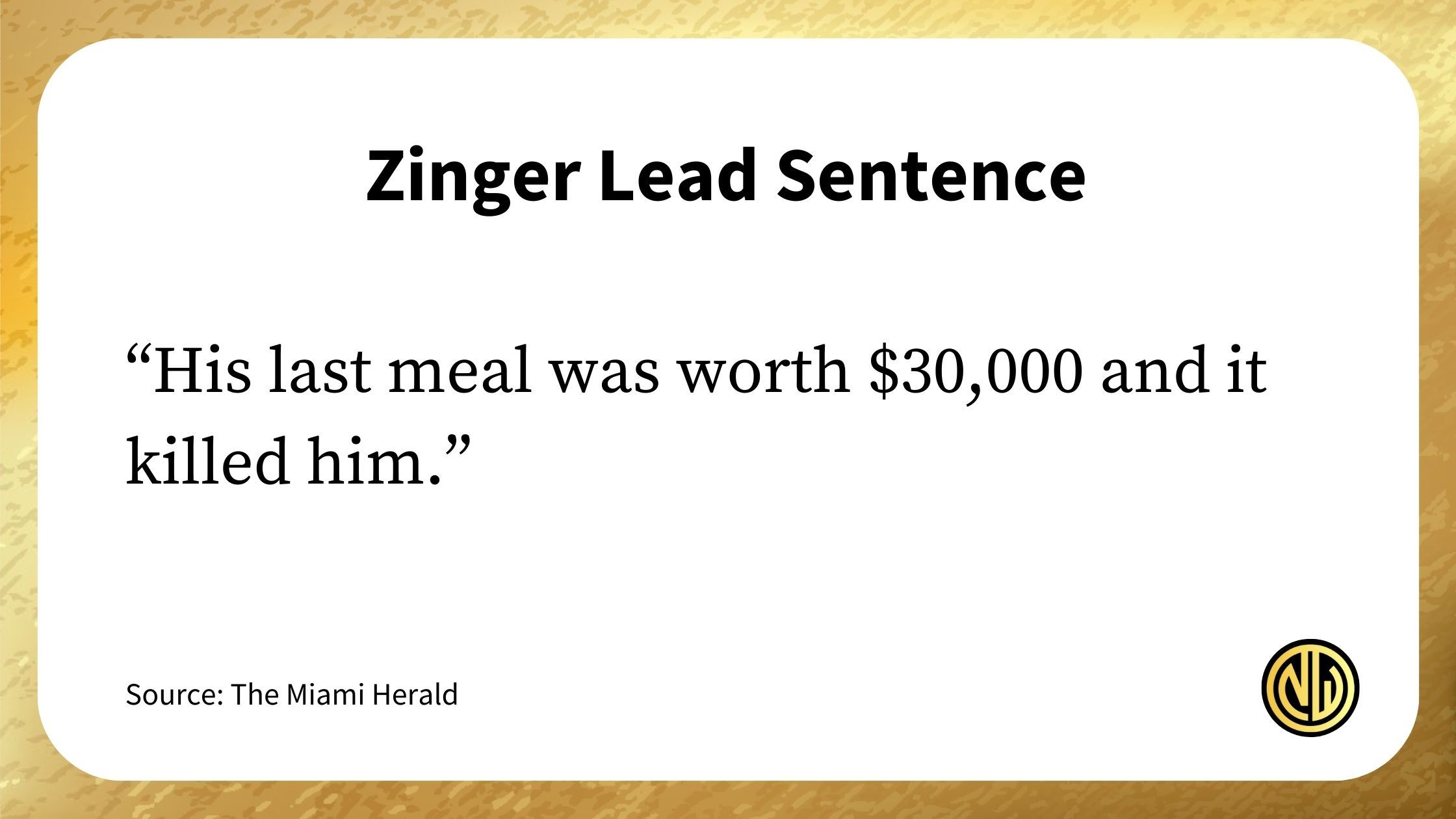
No. 7: First-Person Lead
A first-person lead is the battle ax of many a mom blogger or aspiring opinion columnist. First-person leads are fine for blogging, and they’ve become increasingly popular in our social media-first culture.
However, they also break the fourth wall; if you’re writing a journalistic article or reporting, introducing yourself as a character in your story may be a risk.
Remember, the main goal of a lead is to get a point across quickly. If your personal experience doesn’t contribute to that goal, readers won’t understand what they’re reading, and they’ll check out.
Here is an example from a story by National Public Radio (NPR).
“For many of us, Sept. 11, 2001, is one of those touchstone dates — we remember exactly where we were when we heard that the planes hit the World Trade Center and the Pentagon. I was in Afghanistan.” (7)
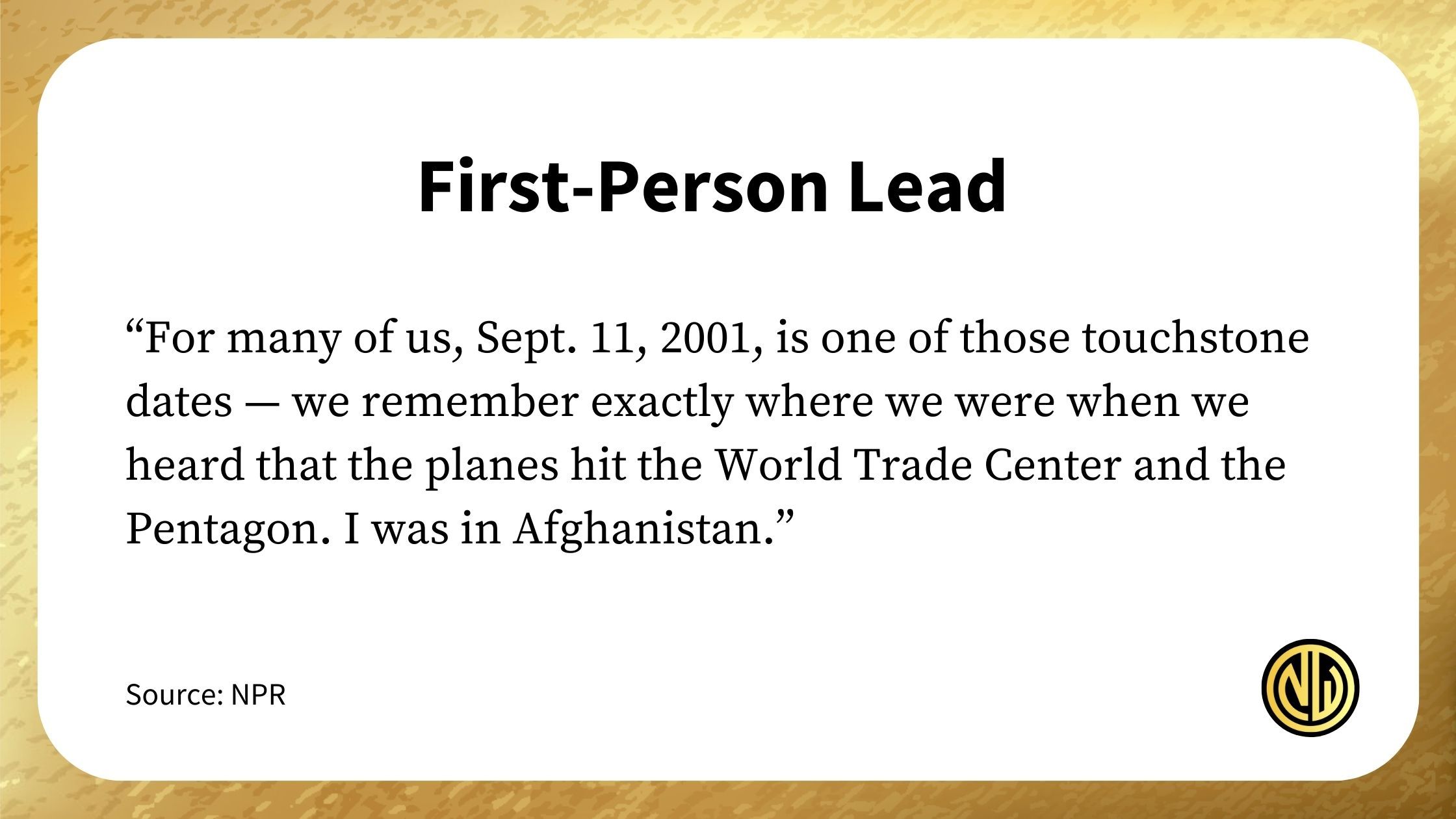
No. 8: Observational Lead
In an observational lead, you project authority by talking about an issue at hand and relating the information back to the big picture.
Observational leads usually aren’t used for breaking news, and they focus more on giving overall context to a situation, rather than just basic facts. They’re a great opportunity to share your perspective, industry savvy, or writing style.
Here are the opening two sentences of a feature from The New York Times that leveraged the observational lead.
“In 2018, senior executives at one of the country’s largest nonprofit hospital chains, Providence, were frustrated. They were spending hundreds of millions of dollars providing free health care to patients. It was eating into their bottom line.” (8)
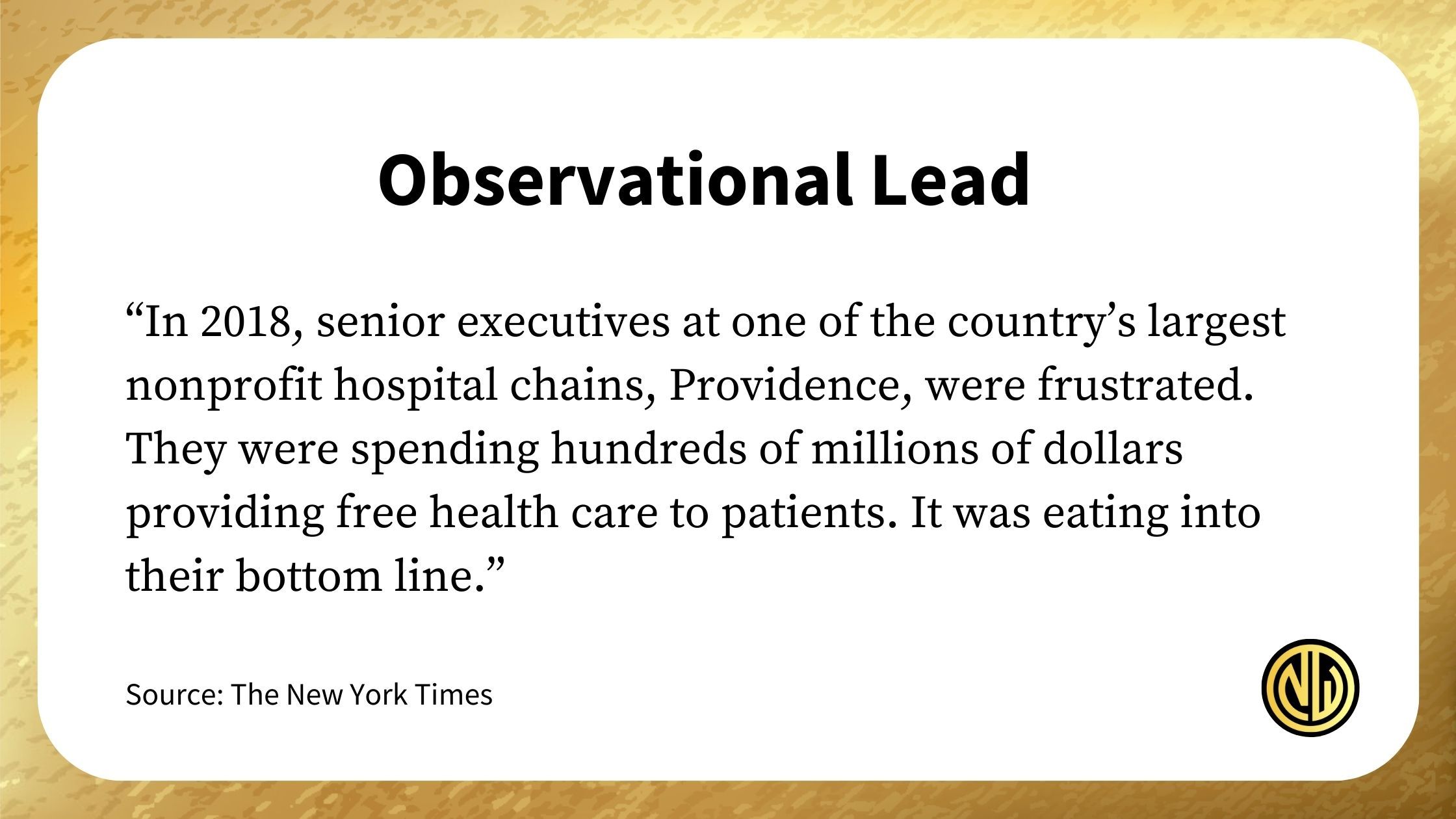
No. 9: Question Lead
A question lead uses question format to create curiosity and intrigue. Since a question lead is not providing details, the second paragraph of your piece will need to pull extra weight and deliver missing details.
Ensure you have this one-two punch in place so that the rhythm of your article reads properly.
Here's a terrific question lead from an article in The Las Vegas Sun.
“What’s increasing faster than the price of gasoline? Apparently, the cost of court lobbyists.
District and Justice Court Judges want to hire lobbyist Rick Loop for $150,000 to represent the court system in Carson City through the 2009 legislative session. During the past session, Loop’s price tag was $80,000.” (9)
Question leads are also popular in SEO writing, especially questions addressed directly to the reader. Most search engine traffic is people with intent who are trying to have their questions answered; this approach is an easier way to hook readers, but it is sometimes considered low-brow.
Let's look at a question lead from Social Media Examiner that followed this format.
“Are you using TikTok or Instagram for business? Looking for a content strategy that works and won’t leave you exhausted?
In this article, you’ll discover a three-step strategy to create highly engaging TikTok and Instagram content that will scale your audience while helping you avoid burnout.” (10)
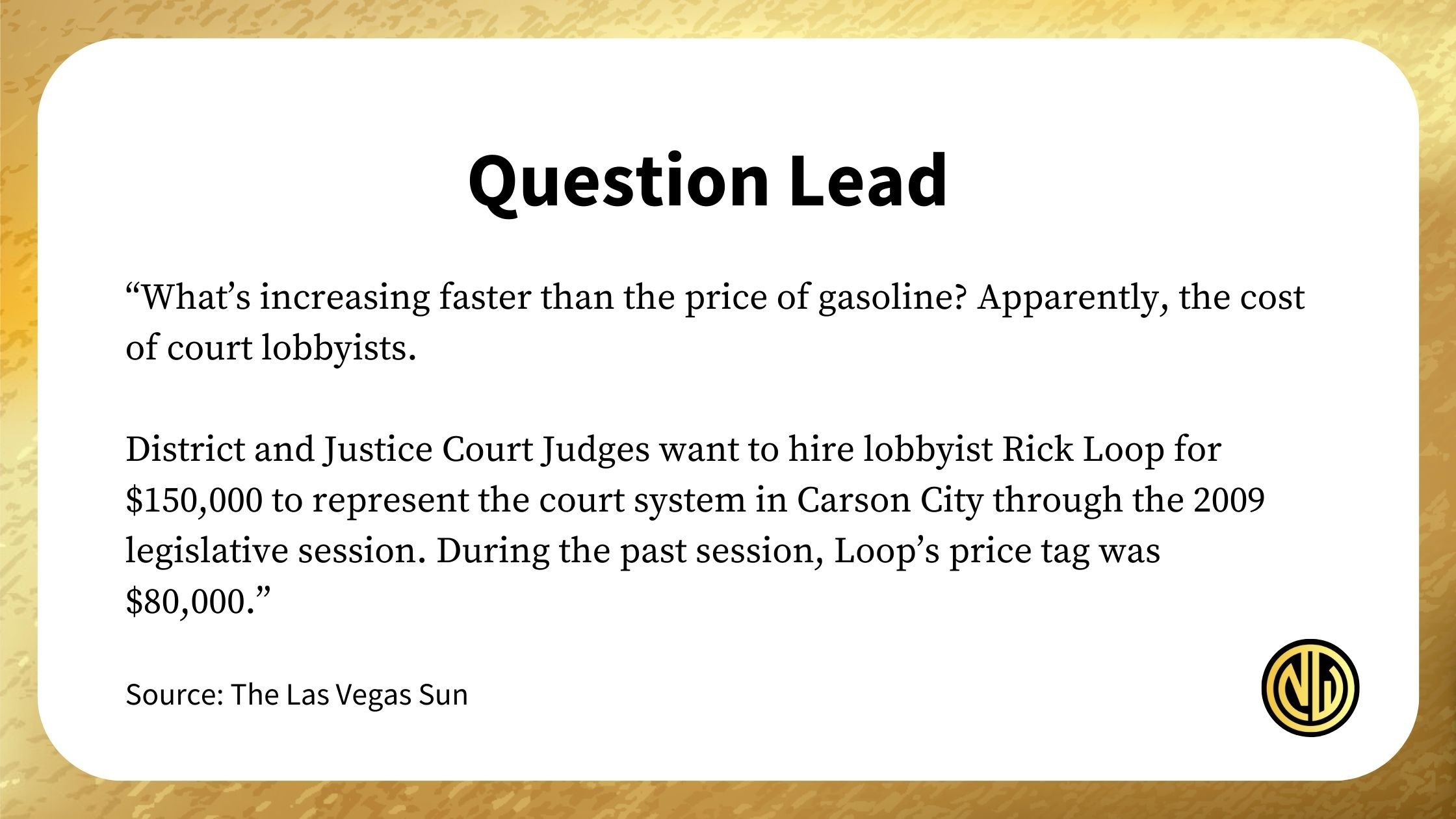
How to Write a Lead: Best Practices to Consider
Come Up With a Good Hook
To write an effective lead, begin with a strong hook that instantly grabs your readers' attention.
Consider using a thought-provoking question, a surprising fact, or an engaging anecdote that relates to the topic. The key is to make your readers curious and eager to find out more.
For example, if you're writing an article about the benefits of exercise, you could start your lead with a captivating question like, "Did you know that just 30 minutes of daily exercise can add years to your life?"
Related: How to Write Powerful Headlines
Know Your Audience
Understanding your target audience is essential to create a lead that resonates well. Consider your readers’ demographics, interests, and motivations.
For instance, if you are writing a lead for a tech-savvy audience, you may want to start with a powerful statistic or a cutting-edge technological breakthrough. On the other hand, if your audience consists of beginners, you could begin with a relatable storytelling approach to ease them into the topic.
Tailoring your lead to the specific interests of your readers will increase their engagement and make them more likely to continue reading. This is a core concept of positioning.
Keep It Short and Concise
In our fast-paced digital age, attention spans are shrinking. To capture your readers' interest and keep them engaged, keep your lead short and concise.
Use clear and concise language to convey your message effectively. Long-winded leads tend to lose readers' interest quickly, so aim for brevity.
Pro Tip:Avoid unnecessary jargon or complex sentences that may confuse or bore your audience. Instead, focus on making your point succinctly and compellingly.
Use Keywords Strategically
In today's digital landscape, search engine optimization (SEO) is a crucial element in writing leads. Strategic placement of relevant keywords helps search engines recognize the relevance of your content and boost its visibility in search results.
When writing your lead, identify the primary keyword or key phrase that represents your topic. For instance, if you're writing an article on budget travel tips, the primary keyword may be "budget travel." Integrate the keyword naturally in your lead to make it more search-engine-friendly and increase your chances of attracting organic traffic.
When Should You Write the Lead for Your News Story?
Consider writing your lead first, then editing your lead last.
The lead will give you a running start, and is usually one of the first things you will write when you sit down in front of a blank page. However, since the lead needs to accurately capture the essence of your article, it’s helpful to have the rest of your piece developed before attempting to summarize it.
Leads are surprisingly challenging to write, but when done well, they make an article sing.
Practice Writing Great Leads Today
When you’re able to communicate a message quickly — whether it be yours or someone else’s — your words will reach more people and make a bigger impact in the long run. ◆


